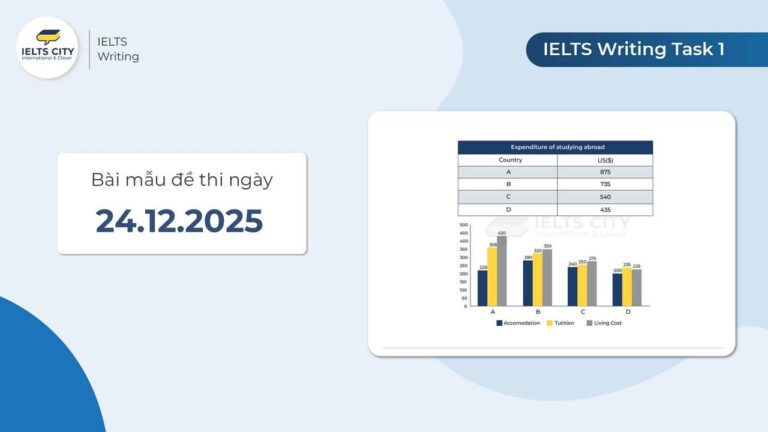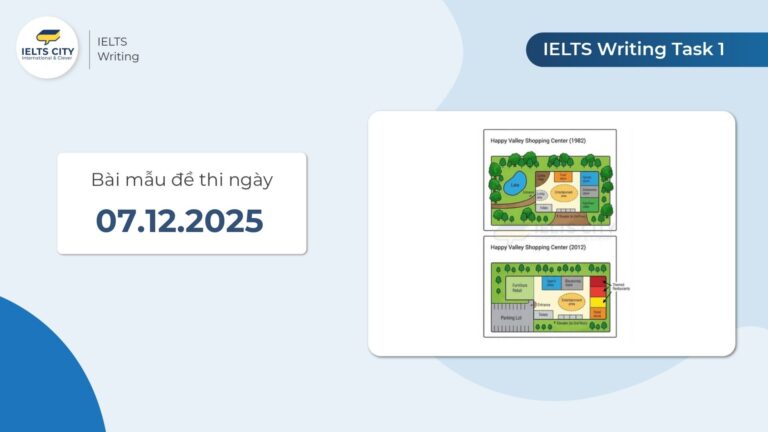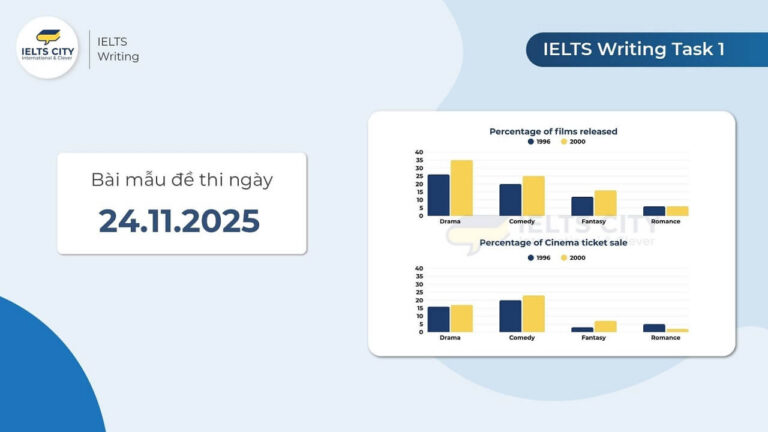Map IELTS Writing Task 1 là một dạng đề được xem là ác mộng đối với các sĩ tử IELTS. Bởi vì với dạng này, các bạn sẽ dùng ngôn ngữ miêu tả hoàn toàn khác so với các dạng biểu đồ như line graph, bar chart,… Vậy làm sao để viết IELTS Writing Task 1 dạng Map hiệu quả? Tại bài viết sau đây, các bạn hãy để IELTS CITY hướng dẫn các bạn cách viết Map IELTS Writing Task 1 điểm cao nhé!

Nội dung chính
Toggle1. Tổng quan về Map IELTS Writing Task 1
1.1. Map IELTS Writing Task 1 là gì?
Trong phần IELTS Writing Task 1, “Map” là một trong những dạng đề yêu cầu thí sinh miêu tả sự thay đổi của một khu vực cụ thể qua các mốc thời gian. Các mốc thời gian này có thể ở trong quá khứ, hiện tại hoặc tương lai. Dạng đề này có thể bao gồm một hoặc hai bản đồ, và nhiệm vụ của thí sinh là so sánh, đối chiếu sự thay đổi giữa các bản đồ đó. Trường hợp thứ 2 đối với dạng này là khi đề bài không đưa ra sự thay đổi theo thời gian mà yêu cầu thí sinh so sánh 2 vị trí được đề xuất của một đối tượng nào đó.
1.2. Các dạng Map trong IELTS Writing Task 1
Không có thời gian
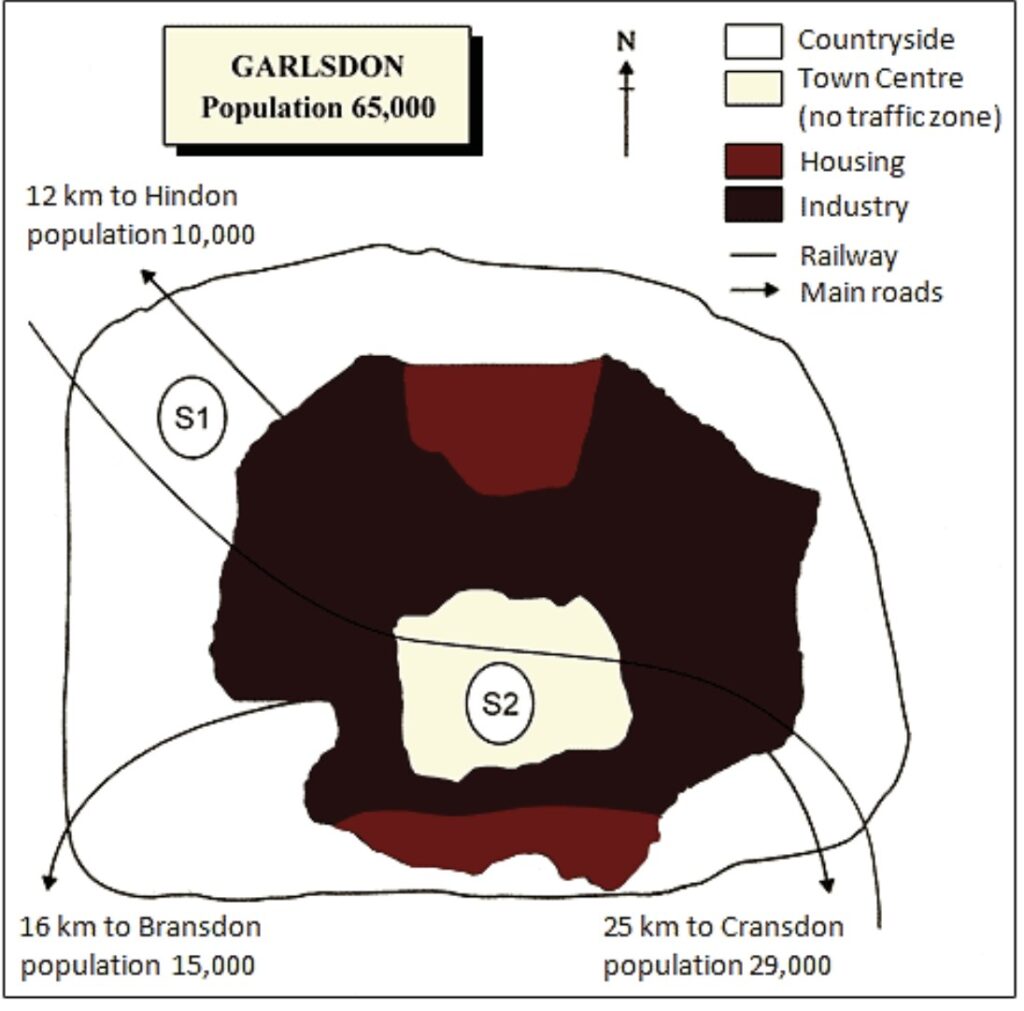
Có sự thay đổi theo thời gian
- Hiện tại và tương lai
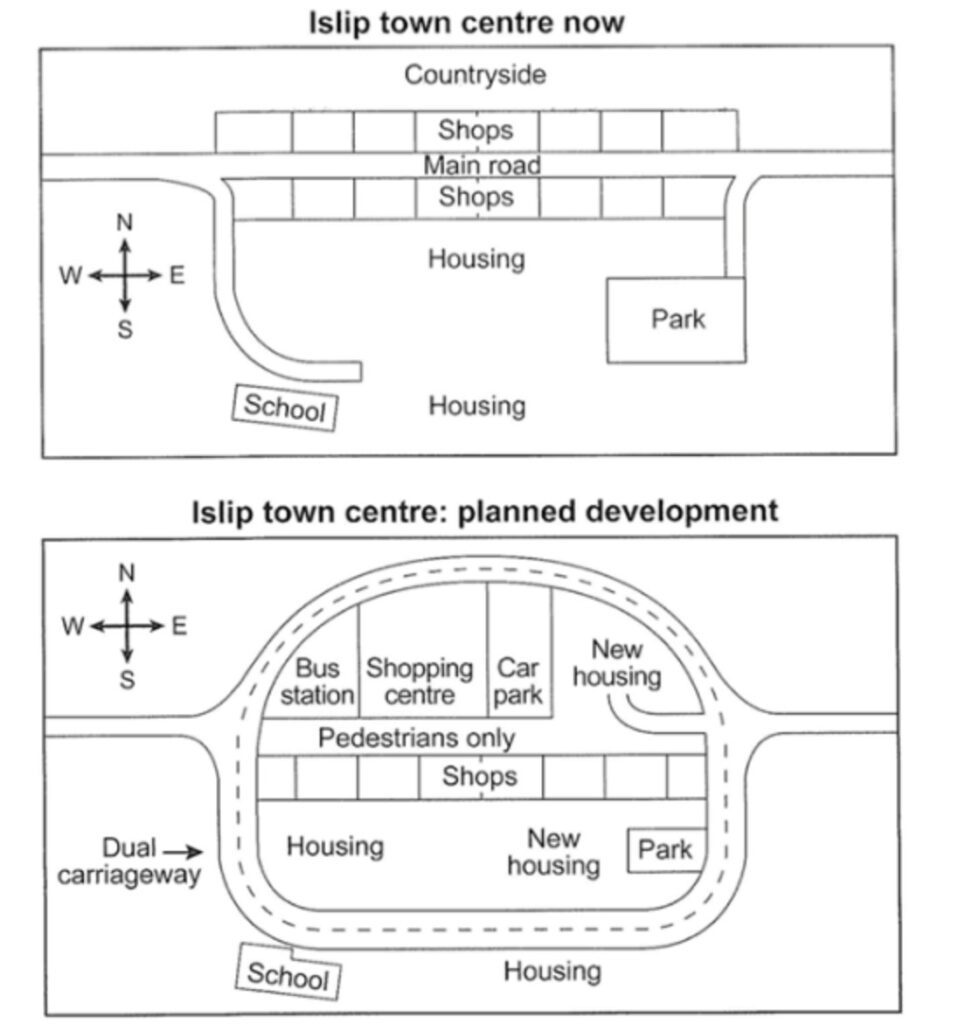
- Quá khứ cho đến hiện tại
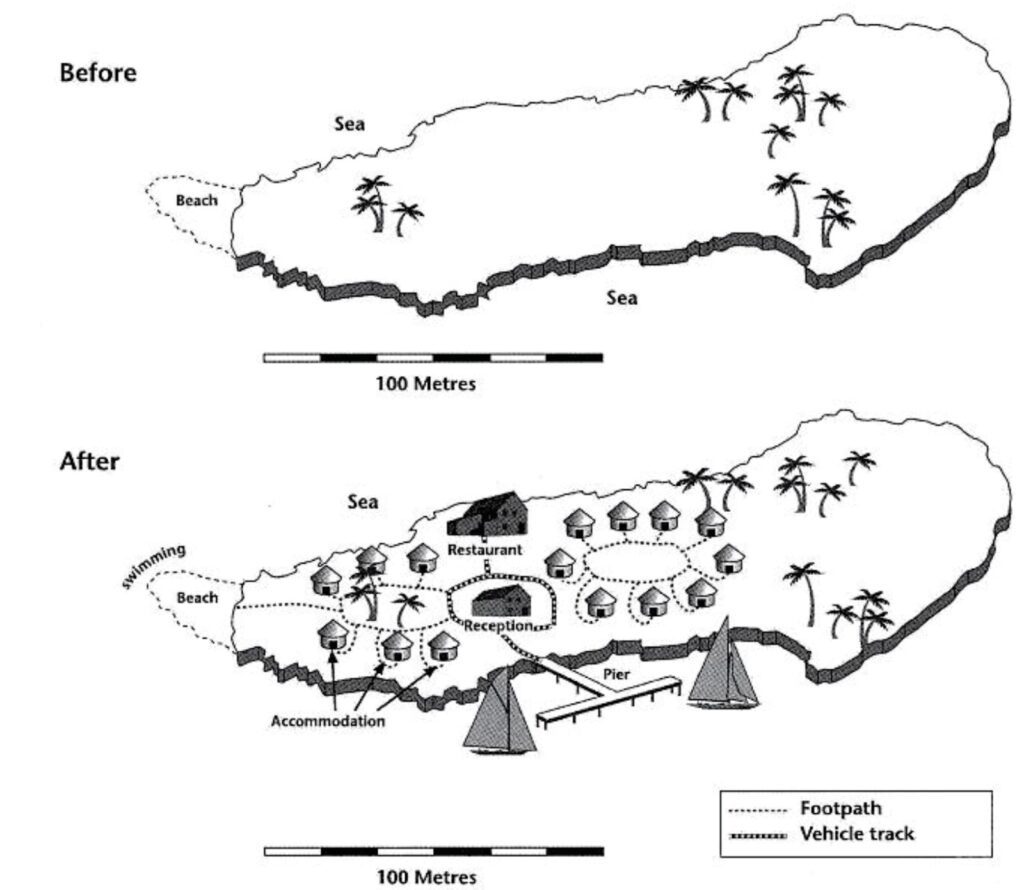
- Nhiều bản đồ trong quá khứ

Đăng ký nhận tư vấn miễn phí
Ưu đãi học phí lên đến 40%
& Cơ hội nhận học bổng trị giá 2.000.000 VNĐ
Đăng ký nhận tư vấn miễn phí
Ưu đãi học phí lên đến 40%
________
2. Cách viết Map IELTS Writing Task 1
The two maps below show an island, before and after the construction of some tourist facilities.

Bước 1: Phân tích đề bài
- Giống với các dạng khác như Bar chart, Line graph,… dạng Map cũng cần đáp ứng 4 tiêu chí bao gồm: Task Achievement (trả lời đầy đủ và đúng trọng tâm câu hỏi), Coherence & Cohesion (tính liền mạch về mặt ngôn từ và ngữ nghĩa), Lexical Resource (từ vựng), Grammatical Range & Accuracy (sự đa dạng và chính xác về ngữ pháp).
- Cấu trúc bài văn cũng bao gồm 4 đoạn, đó là: Introduction, Overview, Body 1, Body 2
- Để phân tích tốt dạng Map, ta cần làm theo các bước sau:
Bước 1: Đọc kỹ câu hỏi và gạch chân dưới keywords, chú ý kỹ những chi tiết có trong bản đồ.
Ví dụ với đề bài phía trên ta sẽ có được những thông tin như sau:
- Đây là một hòn đảo. Những sự xây dựng trên đảo để phục vụ du lịch.
- Trên bản đồ có thước đo, ta có thể ước chừng kích thước của hòn đảo. Bên cạnh đó, ta cũng thấy la bàn (compass) và dựa vào đó ta có thể miêu tả vị trí những toà nhà, và các yếu tố khác trên đảo.
Bước 2: Tìm key features (thông tin nổi bật) bằng cách dựa theo những mục sau:
- Changes in size (thay đổi về kích thước)
- Appearance/disappearance (xuất hiện/biến mất)
- Relocation (di dời)
- Replacement (thay thế)
- Remaining unchanged (không thay đổi)
Với bản đồ trên, ta có thể thấy không có bất cứ sự thay đổi nào về kích thước, di dời hay thay thế. Tuy nhiên có rất nhiều các toà nhà và cơ sở vật chất phục vụ du lịch mới xuất hiện (accommodation, reception, restaurant, footpath, vehicle track, pier, swimming area), và có một yếu tố được giữ nguyên đó là cây xanh (vegetation)
Bước 2: Viết Introduction
Ở phần mở bài, chúng ta cần paraphrase câu hỏi bằng cách sử dụng từ đồng nghĩa hoặc thay đổi cấu trúc câu.
Example: The two maps below show an island, before and after the construction of some tourist facilities.
- the construction of some tourist facilities = it was developed as a tourist destination
-> The two maps show an island both before and after it was developed as a tourist destination.
Example: The maps below show the centre of a small town called Islip as it is now, and plans for its development.
- show = illustrate
- plans for its development = proposed changes
-> The diagrams illustrate some proposed changes to the central area of the town of Islip.
Bước 3: Viết overview
Trong bài IELTS Writing Task 1 dạng “Map”, câu tổng quan (overview) đóng vai trò rất quan trọng. Nó cung cấp một cái nhìn chung về những thay đổi chính mà không đi vào chi tiết cụ thể. Thí sinh nên dùng “umbrella term” (dịch nôm na là từ gọi chung) để tránh đi vào chi tiết.
Dưới đây là ví dụ về câu overview quá chi tiết và cách sửa:
Example: Overall, it is clear that a restaurant and houses were built along with footpath and vehicle track to provide food, accommodation and easy access for visitors. (quá chi tiết)
Correction:
Overall, most development took place on the western and central areas of the island, where a small number of tourist amenities have been built, while the eastern coast has been left in its natural state.
Ở đây ta đang dùng umbrella term đó là “tourist amenities” thay cho “a restaurant and houses”.
Bước 4: Viết body
- Hướng dẫn chia bố cục đoạn body
Viết hai đoạn chi tiết (body paragraphs) trong bài IELTS Writing Task 1 dạng “Map” đòi hỏi bạn phải miêu tả chi tiết sự thay đổi của các yếu tố trên bản đồ một cách rõ ràng và logic. Dưới đây là cách tiếp cận và cấu trúc để viết hai đoạn chi tiết này:
- Chia khu vực theo không gian: Bạn có thể chia bản đồ theo hướng (Bắc – Nam, Đông – Tây) hoặc theo các khu vực cụ thể (khu dân cư, khu thương mại, khu công nghiệp).
- Chia khu vực theo đặc điểm: nhóm các đặc điểm có liên quan lại với nhau
- Chia theo thời gian: mỗi bản đồ là một đoạn body
Hướng dẫn cách viết body cụ thể
- Với bài Map ở trên sẽ có nhiều cách chia. Thí sinh có thể chia theo những đặc điểm xuất hiện (body 1: hut, restaurant, reception); body 2: pier, footpath, vehicle track, swimming area), hoặc chia theo thời gian (body 1: before; body 2: after).
Ví dụ dưới đây được chia theo thời gian:
Prior to development, this relatively small island was uninhabited. In terms of its natural features, there was a beach area on the west coast, and some vegetation, which was more dense on the eastern part of the island. As part of the development programme, this vegetation has largely been retained, with some building work fitting around existing trees.
Following construction, although the island is now more developed, the style of the buildings is generally sympathetic to the natural environment, with relatively simple, single-storey accommodation and only two larger, two-storey buildings. The main structures are a central reception building and a restaurant just north of this. Visitors can stay in hut-style accommodation, which is grouped on either side of the reception. In terms of access, while tracks have been created for vehicles, these are limited to the main buildings. However, there are footpaths linking the accommodation to the swimming beach and other facilities. Reaching the island has been made easier with the addition of a pier on the south coast, which also allows for
3. Từ vựng và cấu trúc câu hay để viết Map
3.1. Từ vựng Map IELTS Writing Task 1
Miêu tả vị trí và phương hướng
- north, south, east, west, northeast, northwest, southeast, southwest
- at the top/bottom
- on the right/left side
- in the top/bottom right/left hand corner
- 10 miles from (10 dặm từ…)
- 10 miles to the right of (10 dặm về phía bên phải của…)
- 10 miles north of (North ở đây dùng như 1 trạng từ)
- in the middle / at the centre
- along (dọc theo)
- across [from]
- opposite
- close to / near / in the vicinity of (gần)
- adjacent to / next to / beside (kế bên)
- … is surrounded by… (được bao quanh bởi)
- … is covered with … (được che phủ bởi)
- … is connected to … via/through/by means of … (được kết nối đến….bằng cách…)
Examples:
A new restaurant has been built to the right of the church.
The residential areas are connected to the city centre via a number of access roads.
The city was surrounded by farmland.
Các động từ thông dụng
| Changes in size | WidenedNarrowedIncreased/decreased in size |
| Disappearance Appearance | Was demolished/destroyedWas removedDisappeared/ VanishedWas cleared |
| Was addedEmergedWas erected/built/constructed | |
| Relocation | was relocatedwas repositioned Was moved to |
| Replacement | ReplacedTook the place ofWas swapped withWas substituted by |
| Remaining unchanged | Kept its original formWas unchangedStayed the sameWas unalteredwas preserved |
Các danh từ thông dụng
Residential/housing area: an area that has lots of houses and some schools.
Industrial area: an area that has lots of factories
Commercial area: an area that has lots of stores
Parking lot: an area where people can park cars
Woodland: an area with lots of trees
Intersection/Junction: the point where several streets meet.
Facilities: recreation/recreational facilities, entertainment facilities, transport Facilities, medical facilities, educational/academic facilities
3.2. Cấu trúc câu hay
Miêu tả sự thay đổi về vị trí và chức năng
- “The [đối tượng] has been replaced by [đối tượng mới].”
- “The old factory has been replaced by a modern shopping mall.”
- “The [đối tượng] has been converted into [chức năng mới].”
- “The farmland has been converted into a residential area.”
- “A new [đối tượng] has been constructed/added in the [khu vực].”
- “A new sports center has been constructed in the northern part of the town.”
- “The [đối tượng] has been relocated to [vị trí mới].”
- “The school has been relocated to the eastern part of the town.”
Miêu tả sự thay đổi về kích thước và quy mô
- “The [đối tượng] has been expanded/enlarged.”
- “The park has been expanded to include a children’s playground.”
- “The [đối tượng] has been reduced in size.”
- “The parking lot has been reduced in size to make room for a new building.”
Miêu tả sự xuất hiện/biến mất
- “The [đối tượng] has been demolished/removed.”
- “The old cinema has been demolished.”
- “The [đối tượng] has been developed/renovated.”
- “The residential area has been developed with new apartment buildings.”
- “The [đối tượng] has been introduced/added.”
- “A new public library has been introduced in the city center.”
Cấu trúc câu miêu tả chi tiết
- “In the [khu vực], [đối tượng] has been [sự thay đổi].”
- “In the northern area, the old houses have been demolished and replaced by modern apartments.”
- “The area around the [đối tượng] has seen considerable changes, with [sự thay đổi].”
- “The area around the river has seen considerable changes, with the construction of a new bridge and walking paths.”
- “One of the most noticeable changes is the transformation of [đối tượng] into [chức năng mới].”
- “One of the most noticeable changes is the transformation of the old factory site into a public park.”
- “To the [hướng], [đối tượng] has been [sự thay đổi], resulting in [kết quả].”
- “To the east, the main road has been widened, resulting in improved traffic flow.”
4. Một số lỗi thường gặp khi viết Map
4.1 Lỗi về mạo từ
Một trong những lỗi sai mà sĩ tử IELTS thường hay gặp nhất đó chính là dùng sai mạo từ ‘a’ và ‘the’ khi kết hợp với các danh từ chỉ địa điểm.
Example:
There was the beach area on the west coast (SAI)
→ There was a beach area on the west coast (ĐÚNG)
Cần lưu ý ta sử dụng “a” với những danh từ (đếm được số ít) được nhắc đến lần đầu tiên, và “the” khi nhắc lại.
4.2. Lỗi về sự chính xác và sự linh hoạt khi sử dụng thì
4.2.1 Sự chính xác
Người viết cần chú ý mốc thời gian được cho ở đề bài để sử dụng các thì trong tiếng Anh một cách chính xác.
Xét ví dụ:
- Prior to development, there is a beach area on the west coast, and some vegetation, which is more dense on the eastern part of the island (SAI)
→ Prior to development, there was a beach area on the west coast, and some vegetation, which was more dense on the eastern part of the island. (ĐÚNG)
Câu trên miêu tả hòn đảo trước khi sự thay đổi được diễn ra nên thí sinh cần sử dụng thì quá khứ đơn để mô tả các sự thay đổi trong bản đồ.
4.2.2 Sự linh hoạt
Ví dụ dưới đây thí sinh chỉ dùng rất hạn chế thì và lặp cấu trúc (there is/there are):
There are two blocks of accommodation and there is a reception and a restaurant between them.
The restaurant is connected to a pier by a vehicle track.
Bài sửa:
Two blocks of accommodation have been built so that tourists can now stay on the island, and there is also a reception and a restaurant for them to use. (hiện tại hoàn thành được sử dụng cùng với hiện tại đơn)
The restaurant is connected to a pier by a vehicle track, making the building more accessible. (sử dụng thêm mệnh đề quan hệ rút gọn để đa dạng hoá cấu trúc)
4.3. Lỗi các động từ ở thể bị động và chủ động
Tuy đa phần các diễn đạt của bài Maps được viết ở câu bị động, vẫn có một số các động từ chỉ được dùng ở dạng chủ động. Thí sinh cần lưu ý để tránh nhầm lẫn khi luyện tập cũng như khi làm bài thi.
Ví dụ 1:
- A large number of buildings were built. (ĐÚNG)
- The island was increased in size. (SAI)
→ The island increased in size. (ĐÚNG) - ‘increase’ là nội động từ, có nghĩa ‘tăng lên’, do đó chỉ được dùng trong câu chủ động.
Ví dụ 2:
- A significant development was taken place in the village. (SAI)
- A significant development took place in the village. (ĐÚNG)
- ‘take place’ cũng là nội động từ, mang nghĩa ‘xảy ra’ và cần viết dưới dạng chủ động.
4.4. Lỗi về giới từ
- in the corner và at the corner
In the corner được sử dụng để chỉ vị trí bên trong một không gian có góc, ví dụ như trong một phòng hoặc một khu vực cụ thể.
“In the south-west corner of the school grounds, a new science building has been constructed.” (Trong góc tây nam của khuôn viên trường học, một tòa nhà khoa học mới đã được xây dựng.)
At the corner thường được sử dụng để chỉ vị trí tại một giao lộ hoặc điểm giao nhau giữa hai con đường.
“At the corner of Main Street and Elm Street, a new café has opened.” (Tại góc đường Main và Elm, một quán cà phê mới đã mở cửa.)
5. Bài mẫu Map IELTS Writing Task 1
Note: mỗi bài mẫu sau sẽ trình bày áp dụng các bước ở mục 2 (Phân tích đề bài, Viết Intro,…)
5.1. Bài mẫu dạng 1 bản đồ (không có thời gian)
Đề bài: The map below is of the town of Garlsdon. A new supermarket (S) is planned for the town. The map shows two possible sites for the supermarket.

Phân tích đề bài:
- Introduction: Giới thiệu về địa điểm và thời gian diễn ra sự thay đổi.
- Overview: Chỉ ra điểm khác nhau và giống nhau nổi bật nhất giữa 2 vị trí.
- Body 1: vị trí S1
- Body 2: vị trí S2
Bài mẫu:
The map compares two potential locations for the building of a new supermarket in a town called Garlsdon.
The main difference between the two sites is that one is located in the countryside outside the town, whereas the other is in the town centre. Both potential sites are close to the railway, and reasonably near to a main road.
The first possible site for the supermarket (S1) is located in an area of countryside to the north west of Garlsdon. It is close to the railway line and to a main road connecting Garlsdon to the smaller town of Hindon. It is also situated near to the residential housing area of Garlsdon.
The second site (S2), by contrast, is in Garlsdon town centre. It is also accessible by rail, but not by road because the town centre is a no-traffic zone. Despite this, the main roads to Cransdon, Bransdon and Hindon are not too far away. The distance to Garlsdon’s housing area is similar to the distance from S1 to the same area.
5.2. Bài mẫu dạng 2 bản đồ hiện tại và tương lai
Đề bài: The maps below show the centre of a small town called Islip as it is now, and plans for its development.

Phân tích đề bài:
- Introduction: Giới thiệu về địa điểm và thời gian diễn ra sự thay đổi.
- Overview: Chỉ ra điểm thay đổi nổi bật nhất đó là “ring road” và một số thay đổi liên quan đến “shops and housing”
- Body 1: Miêu tả sự thay đổi liên quan đến hệ thống giao thông
- Body 2: Miêu tả sự thay đổi liên quan đến “shops and housing”
Bài mẫu
The diagrams illustrate some proposed changes to the central area of the town of Islip.
It is clear that the principal change to the town will be the construction of a ring road around the centre. Various other developments with regard to shops and housing will accompany the building of this road.
Looking at the map of Islip as it is now, we can see that a main road runs through its centre from east to west. The second map shows the planned pedestrianisation of this road. Traffic will be diverted onto a dual carriageway that will form a ring around the town centre.
Currently there is a row of shops along either side of the main road. However, it appears that the shops along the north side of the new pedestrian street will be demolished to make way for a bus station, shopping centre, car park and new housing area. The shops along the south side of the street will remain, but it seems that the town’s park will be reduced in size so that more new houses can be built within the ring road.
5.3. Bài mẫu dạng 2 bản đồ quá khứ và hiện tại
Đề bài: The plans below show a public park when it first opened in 1920 and the samepark today. Summarise the information by selecting and reporting the main features, and make comparisons where relevant.

Phân tích đề bài
- Introduction: Giới thiệu về địa điểm và thời gian diễn ra sự thay đổi.
- Overview: Chỉ ra có sự xuất hiện và mở rộng của những khu vực liên quan đến giải trí; sự di dời đáng chú ý liên quan đến chỗ ngồi; có những khu vực được giữ nguyên.
- Body 1: Miêu tả sự thay đổi ở trung tâm và phía bên trái
- Body 2: Miêu tả sự thay đổi liên quan khu vực gần lối vào và bên phải bản đồ
Bài mẫu
The maps detail the changes since 1920 to today of Grand Park.
Looking from an overall perspective, it is readily apparent that the park added and expanded areas mainly related to entertainment including a larger stage and various areas for recreation. There was also significant relocation in terms of seating and the only areas that remained the same were the entrances and one minor garden.
The most striking change is in the center of the park where the fountain has been removed in favour of a rose garden with full seating around it. To the left of the new garden, the previous stage for musicians has been turned into a much larger ampitheatre facing the opposite direction that will allow for concerts in the park. This change has necessitated the removal of both seating on the far left side as well as the rose garden in the bottom left corner of the map.
The entrances at the top and bottom in the middle have remained unchanged but on the right side a cafe has replaced the rose garden and where there was a pond for water plants in the top right corner, there is now a children’s play area. Instead of the pond, a water feature has been built occupying the bottom right corner (replacing a glasshouse and some seats). Finally, leading to the water park is a new entrance for an underground car park.
5.4. Bài mẫu dàng nhiều bản đồ trong quá khứ
Đề bài: The two maps below show road access to a city hospital in 2007 and 2010. Summarise the information by selecting and reporting the main features, and make comparisons where relevant.

Phân tích đề bài
- Introduction: Giới thiệu về địa điểm và thời gian diễn ra sự thay đổi.
- Overview: Chỉ ra có 3 điểm thay đổi chính đó là “a new bus station, new roundabouts and new parking facilities”
- Body 1: Miêu tả sự thay đổi liên quan “bus stop” và “new roundabout”
- Body 2: Miêu tả sự thay đổi liên quan đến “parking facilities”
Bài mẫu
The maps illustrate some changes that were made to a city hospital’s transport infrastructure between the years 2007 and 2010.
It is noticeable that three main modifications were made to the hospital’s vehicle access. These involved the building of a new bus station, new roundabouts and new parking facilities.
Looking at the changes in more detail, we can see that in 2007 there were three bus stops on either side of Hospital Road. These were no longer present in 2010, and instead we see the addition of a bus station on the west side of Hospital Road. This bus station is accessed via two new roundabouts; the first roundabout is at the intersection of City Road and Hospital Road, while the second is at the other end of Hospital Road, at the junction with the hospital ring road.
The two maps also show that changes were made to public and staff parking areas. In 2007, staff and visitors used the same car park, which was situated to the east of Hospital Road and accessed via the ring road. However, by 2010 this original car park had become a designated area for staff parking only. A new car park, located on the east side of the ring road, provided parking for members of the public.
6. Cập nhật đề Map mới nhất tháng 12 năm 2025
13.12.2025
The plans show a student common room from five years ago and now. Summarize the information by selecting and reporting the main features and make comparisons where relevant.
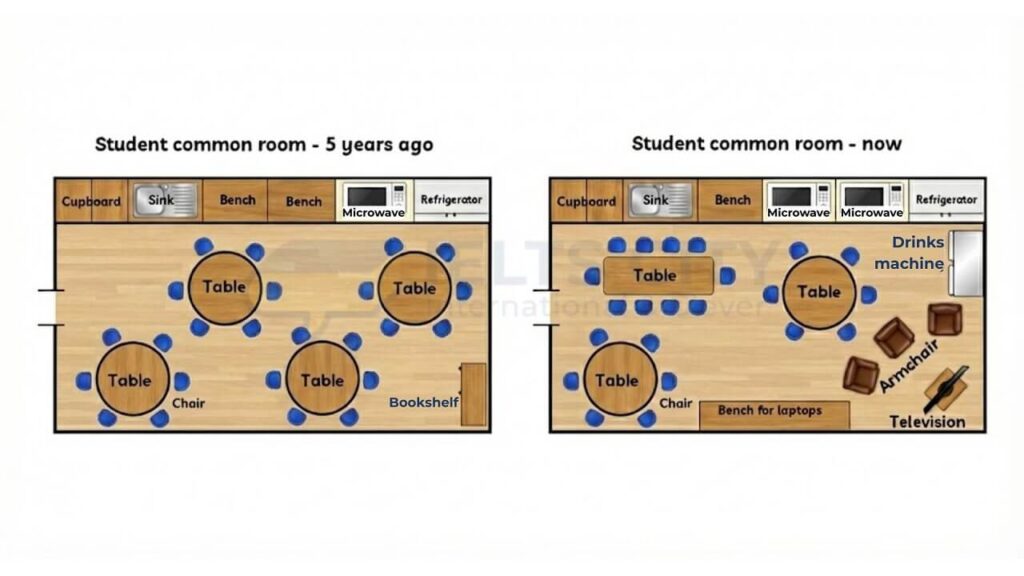
Tham khảo: Bài mẫu đề thi IELTS Writing Task 1 dạng Maps ngày 13.12.2025
10.12.2025
The maps below show a part of a village in 1910 and the same part of the village in 2010. Summarize the information by selecting and reporting the main features and make comparisons where relevant.
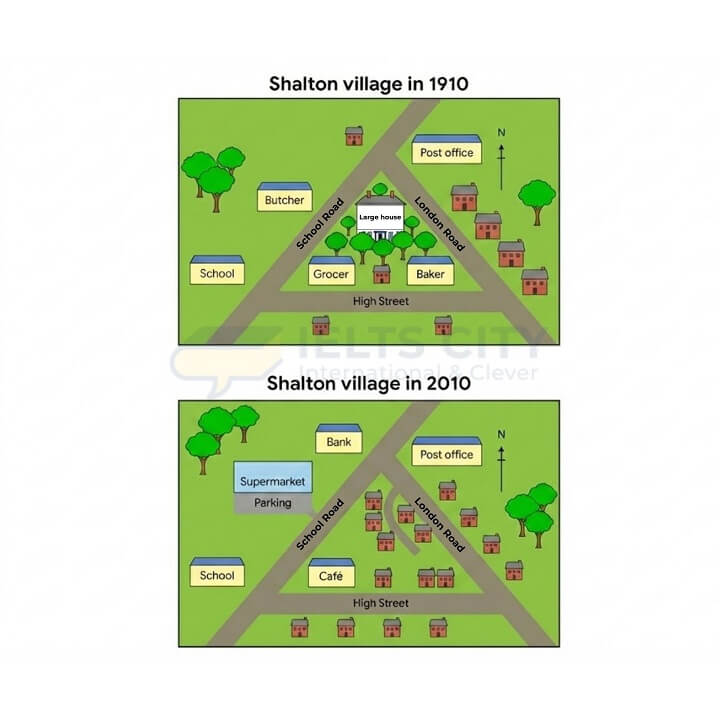
Tham khảo: Bài mẫu đề thi IELTS Writing Task 1 dạng Maps ngày 10.12.2025
07.12.2025
The diagrams below show changes in Happy Valley Shopping Centre in 1982 and 2012. Summarize the information by selecting and reporting the main features and make comparisons where relevant.

Tham khảo: Bài mẫu đề thi IELTS Writing Task 1 dạng Maps ngày 07.12.2025
Cập nhật đề thi và bài mẫu mới nhất tại: Đề thi IELTS Writing 2025
Hy vọng rằng với những chia sẻ kiến thức về cách viết Map IELTS Writing Task 1 trên của IELTS CITY sẽ giúp các bạn nắm được cấu trúc viết bài cũng như các ngôn ngữ cần thiết để miêu tả mọi loại bản đồ. Chúc các bạn chinh phục band điểm thật cao khi gặp dạng Map trong IELTS Writing Task 1 nhé!
Bài hướng dẫn cách viết các dạng khác:


